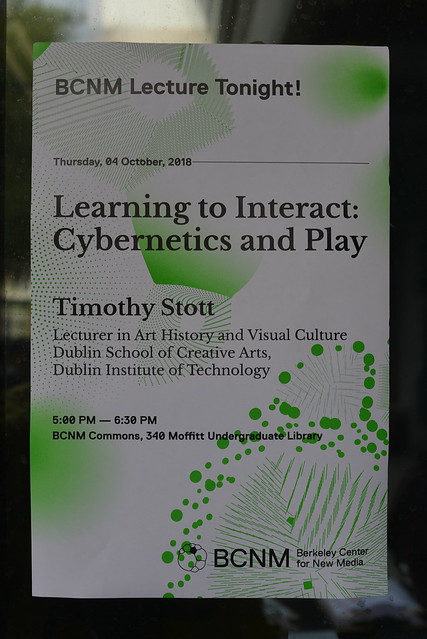HTNM Revisited: Tim Stott

Recap by Tara Shi, 2018 - 2019 Graduate Liaison for the History Theory and New Media Lecture series
Learning to Interact: Cybernetics and Play with Tim Stott
Focusing on three exhibits and an experimental design course from the late 1960’s, Timothy Stott zooms in on a shared history of play and cybernetics to argue for a contemporary ludo-literacy. In support, he presented a rich collage of material from his current book project A Constructive Intelligence: Art, Design and Play After World War Two. His lecture drew together contributions of cybernetic artists, systems theorists, playground designers, educational toymakers, and the many other grounds of convergence of cybernetics and play from the 1950’s onwards.
For Stott, the uncoupling of play from a concept of individual expression to a “constructive intelligence”, or intuition plus intellect, was a critical departure from previous generations. In the 50’s, cybernetics first began appearing in the field of art and design. Practitioners began thinking of their creative acts as systems buildings, rather than object making, exemplified by experimenters like Allan Kaprow, Gyorgy Kepes, and Ray and Charles Eames.
Cybernetics also began entering the public consciousness through popular mediums like radio. In 1973, Stafford Beer broadcasted on Canadian public radio his theory of cybernetic organization. He introduced a diagrammatic metaphor of a group of people connected by strings with a ball representing their output dangling from the center. An unruly cat playing with the ball represented environmental disturbances. Beer sets forth 3 organizational responses: shoot the cat, top-down regulation, or play with the cat. Stott meditates on the act of play here as a way of managing complexity, increasing local variation to decrease global entropy. In play, unknown processes like black boxes or unpredictable cats can promote understanding.
With this definition of cybernetic play, Stott brings in two exhibits, both curated by Jasia Reichardt at the ICA in London in late 60’s. While Cybernetic Serendipity (1968) and Play Orbit (1969) shared in a participatory and ludic way of engaging museum goers, the first was an explicit search for the connection between technology and creativity via cybernetics, while the later much less technological.
Stott highlights the greatest achievement of Cybernetic Serendipity as a public demonstration of a new human-computer interaction: Play. While our contemporary everyday is full of computational objects for recreation - like smartphones for social media and our laptops to netflix-and-chill - computing machines at that time were often not publically accessible and surely not fun. Among the most famous of the 130+ works by composers, engineers, artists, mathematicians and poets exhibited was Gordon Pask’s Colloquy of Mobiles (1968). The interactive installation was composed of a small group of suspended, gendered robots in ‘conversation’. With light beams, ‘males’ sought ‘females’ to ‘discharge’ their capacitors while visitors were invited to interrupt and engage. While this anthropomorphic stereotyping is problematic, Pask’s experimentation with reciprocity and self-organization, with people’s ability to cause change in the system, was especially noteworthy.
From a totally different angle, Play Orbit, organized in collaboration with Peter Jones, was a group exhibition of 100 toy-like or game-like works of art selected without jury, setting a stage for student work and many lesser known early career artists. Introducing toys required not only temporary architectural changes to the museum, but also required an expansion to the public idea of what an art space could be. Play was the organizing principle of interaction and self-regulation between the objects on show and the visitors. Thru participation, one could even alter the work itself. However, Stott asserts - toys needed to remain as black boxes that were just closed enough, so that the toy may ‘retain its soul’, as Charles Baudelaire would put it. Screening footage children playing with Gordon Fletcher’s Wobbler, a bouncy tentacled toy, it is clear how the black box is tested thru play, toy’s soul becomes precarious as it gets nearly wobbled to the point of disintegration. In the Q&A portion, Stott further discusses the idea of the toy as black box, adding that perhaps it exists in orders. Like Matryoshka dolls, a constant conceptual reframing occurs when each new layer is exposed thru play.
Simon Nicholson, a contributing artist and designer to Play Orbit, took these types of experiments to academia. Teaching many versions of Design 12 across UC Campuses in the 1960’s, Nicholson connected play to systems building and testing. Often designing educational toys and ‘miniature environments’, college students in the course built off a cybernetic logic of testing, feedback, evaluation and adaptation, all centered on play and trials with local children. For Nicholson, participatory designs like adventure playground fostered community involvement later in life. Self-discovery, was central to learning and congruous to the new idea of play as a constructive intelligence.
The final exhibit Stott introduces is Options, shown at the Milwaukee Art Center and the Museum of Contemporary Art in Chicago in 1968. Curated by Lawrence Alloway, the exhibit showcased ‘arenas for human activities’ and design systems that could incorporate the attention of numerous spectators and ‘noise’. For Stott, Tony Martin’s Game Room (1967) exemplified a system with noise, creating surprise and even frustration for the player with its non-corresponding latencies and lack of instructions for gameplay. With a choice of ‘options’ of engagement left to the players, a situation where ‘new grammars of play’ might arise.
In his research and work, Stott hopes to contribute to the history of the ludification of culture. For him, the late 1960’s was a especially critical moment for a generation of players trained to relate to new medias and interactive technologies thru play. While the present is saturated by personal and infrastructural machines, augmented and virtual spaces, perhaps with a deeper understanding of our ludic culture we might find new ways of relating to the playful cat batting at the ball.

